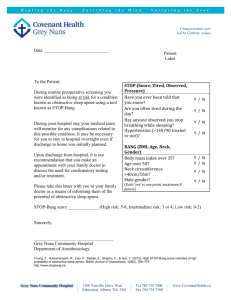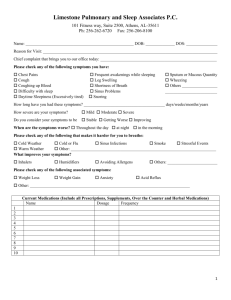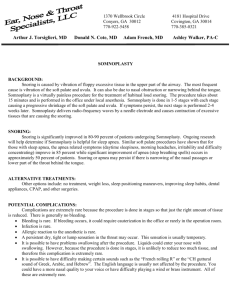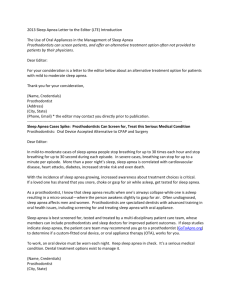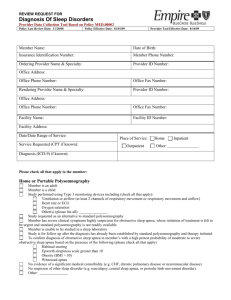Obstructive Sleep Apnea - Intermountain Healthcare
advertisement
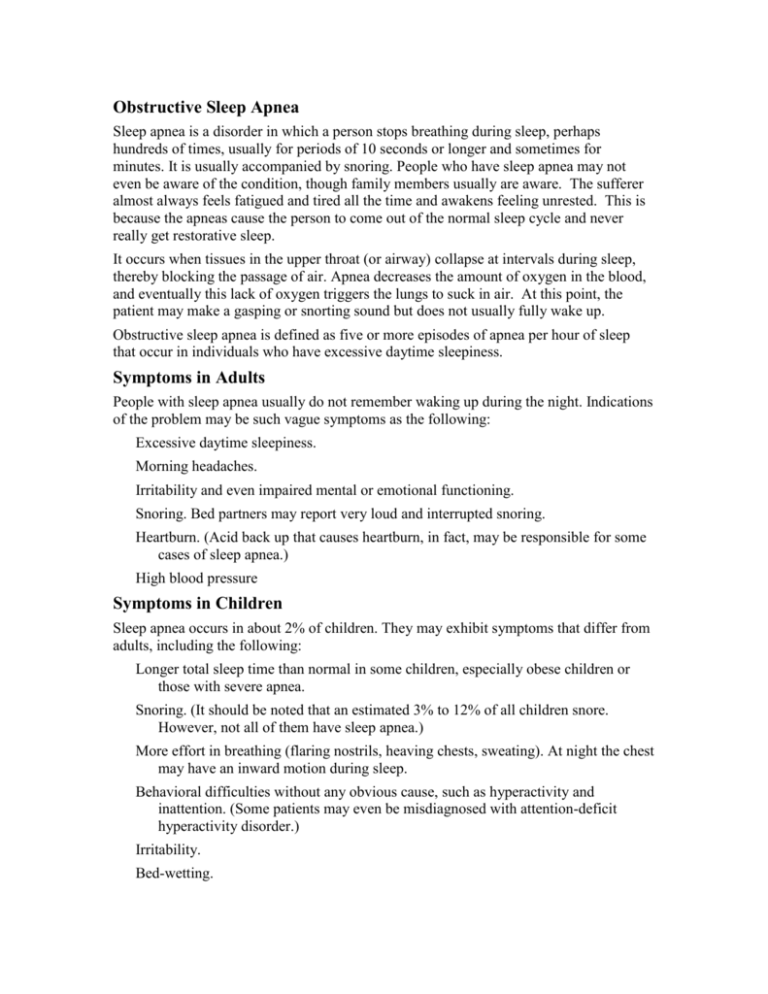
Obstructive Sleep Apnea Sleep apnea is a disorder in which a person stops breathing during sleep, perhaps hundreds of times, usually for periods of 10 seconds or longer and sometimes for minutes. It is usually accompanied by snoring. People who have sleep apnea may not even be aware of the condition, though family members usually are aware. The sufferer almost always feels fatigued and tired all the time and awakens feeling unrested. This is because the apneas cause the person to come out of the normal sleep cycle and never really get restorative sleep. It occurs when tissues in the upper throat (or airway) collapse at intervals during sleep, thereby blocking the passage of air. Apnea decreases the amount of oxygen in the blood, and eventually this lack of oxygen triggers the lungs to suck in air. At this point, the patient may make a gasping or snorting sound but does not usually fully wake up. Obstructive sleep apnea is defined as five or more episodes of apnea per hour of sleep that occur in individuals who have excessive daytime sleepiness. Symptoms in Adults People with sleep apnea usually do not remember waking up during the night. Indications of the problem may be such vague symptoms as the following: Excessive daytime sleepiness. Morning headaches. Irritability and even impaired mental or emotional functioning. Snoring. Bed partners may report very loud and interrupted snoring. Heartburn. (Acid back up that causes heartburn, in fact, may be responsible for some cases of sleep apnea.) High blood pressure Symptoms in Children Sleep apnea occurs in about 2% of children. They may exhibit symptoms that differ from adults, including the following: Longer total sleep time than normal in some children, especially obese children or those with severe apnea. Snoring. (It should be noted that an estimated 3% to 12% of all children snore. However, not all of them have sleep apnea.) More effort in breathing (flaring nostrils, heaving chests, sweating). At night the chest may have an inward motion during sleep. Behavioral difficulties without any obvious cause, such as hyperactivity and inattention. (Some patients may even be misdiagnosed with attention-deficit hyperactivity disorder.) Irritability. Bed-wetting. Morning headaches. Failure to grow and gain weight. Causes Structural Abnormalities Any structural abnormality in the face, skull, or airways that causes some obstruction or collapse in the upper airways and reduces air pressure can produce sleep apnea syndrome. Obesity is the most common underlying cause in adults. Obesity is strongly associated with sleep apnea and there is some evidence it may be a cause of it in some cases. Imaging scans have shown fatty cells infiltrating the throat tissue, which suggests that they could narrow the airways. In one study, the more obese a person with sleep apnea was, the higher the pressure on the airway and therefore the greater the obstruction of the airway. (Obstructive sleep apnea may also contribute to obesity itself, however. A sleepy person tends to be sedentary.) Snoring. Chronic snoring itself may actually be a cause of some cases of sleep apnea. Over time the vibrations and the increased pressure against the upper airways as snoring people inhale may cause the soft palate to lengthen. This stretched palate is more prone to collapse and obstruction. It should be stressed that snoring is very common. Snoring occurs in about a third of the population, while apnea, according to one study, occurs in only 6%. Snoring, then, does not always cause apnea, nor is it always a sign of the respiratory disorder. Furthermore, while snoring is also associated with daytime sleepiness regardless of whether apneas are present, snoring alone does not appear to pose any major health risks. Smoking and Alcohol Use Smoking. Smokers are at higher risk for apnea, with heavy smokers (more than two packs a day) having a risk 40 times greater than nonsmokers. Alcohol. Alcohol use has been associated with apnea, although studies are mixed. A major 1999 survey reported that 53% of people who use alcohol to sleep experience symptoms of sleep apnea. Another study found no relationship. Medical Conditions Related to Sleep Apnea Diabetes. Diabetes is associated with sleep apnea and snoring. It is not clear if there is an independent relationship between the two conditions or whether obesity is the only common factor. Gastroesophageal Reflux Disease (GERD). Gastroesophageal reflux disease (GERD) is a condition caused by acid backing up into the esophagus and is a common cause of heartburn. GERD and sleep apnea often coincide. In one study, almost half of apnea patients had symptoms of GERD, and these symptoms also tend to be worse at night and in the morning and particularly hard to treat. Some experts suggest that the back of up of stomach acid in GERD may produce spasms in the vocal cords (larynx), thereby blocking the flow of air to the lungs and causing apnea. Or, apnea itself may cause pressure changes that trigger GERD. Some evidence, in fact, suggests that treating sleep apnea with continuous positive airway pressure (CPAP) may reduce GERD symptoms by nearly 50%. It should be noted, however, that obesity is frequent in both conditions and may be the common factor. More research is needed to clarify the association. Polycystic Ovary Syndrome (PCOS). In one 2000 study, women with polycystic ovary syndrome (PCOS) were 30 times more likely than other premenopausal women to have obstructive sleep apnea and excessive daytime sleepiness. In PCOS women produce high amounts of androgens (male hormones), particularly testosterone. The elevated levels of male hormones can cause obesity, facial hair, and acne. About half of PCOS patients also have diabetes. Obesity and diabetes are both associated with sleep apnea and may be the common factors. Chronic Problems in the Upper Airways. A 2001 Swedish study found that people with respiratory tract disorders, including asthma, chronic bronchitis, or seasonal allergies, reported symptoms of sleep apnea more often than those without any of these ailments. Not all research supports the association, however, and more studies are needed. Hypothyroidism. In rare cases, hypothyroidism has been reported as possible cause of sleep apnea. In such cases, treating the thyroid condition improves the sleep apnea. Causes of Sleep Apnea in Small Children Sleep apnea occurs in about 2% of children and can occur even in very young children. The most likely causes are the following: Facial or skull abnormalities in infants. Overgrown tonsils, adenoids, or both in small children. (Removal of tonsils or adenoids can free the airways and solve the problem.) Premature infants also commonly have a form of apnea that may be related to lung or nervous system problems. Consequences of Sleep Apnea Higher Risk for Accidents As many as 200,000 automobile accidents in the US and 1,500 deaths from such accidents are caused by sleepiness. Studies continue to report that drowsy driving is as risky as drunk driving. Estimates on fatigue as a cause of automobile crashes range from 1% to 56%, depending on the study. In a major 1995 poll, for example, 33% of those surveyed said they had fallen asleep while driving, and 10% of these people had had accidents because of this. One study strongly suggested that it was habitual sleepiness, however, and not just being sleepy at the time of an accident that places people at higher risk. Furthermore, some researchers believe that sleepiness associated with sleep apnea is the greatest risk factor for car accidents. Two studies in 1997 and 1998, respectively, reported that people with sleep apnea have two to three times as many car accidents, and five to seven times the risk for multiple accidents. Sleep Apnea as a Cause of Obesity Obesity and sleep apnea are a chicken and egg problem. It is not always clear which condition is responsible for the other. For example, obesity is often a risk factor and possibly a cause of sleep apnea, but it is also likely that sleep apnea increases the risk for weight gain: Some studies indicate that sleep apnea disrupts rapid eye movement (REM) sleep, which, in turn, increases the risk for obesity. Research indicates that animals deprived of REM sleep tend to eat more. People with apnea may also become too tired to exercise and so put on weight. Adverse Effects of Sleep Apnea on Heart and Circulation Sleep apnea has a strong association with heart and circulation diseases. The links are not fully clear. Researchers are intensively investigating why a problem in the upper airways is associated with these serious conditions. Here are some findings: Obesity, smoking, and alcohol abuse, known risk factors for hypertension and heart disease, are also associated with sleep apnea. These factors, however, do not explain all cases of higher heart-related risks in people with sleep apnea. For example, among overweight people, those who have sleep apneas have a greater risk of heart problems than those without them. When breathing stops during episodes of apnea, carbon dioxide levels in the blood increase and oxygen levels drop. This effect may trigger a cascade of physical and chemical events that can then increase risk for these conditions. Apnea also causes decreased levels of the gas nitric oxide (NO), a potent substance that causes blood vessels to be elastic and expand. NO plays a crucial role in blood pressure control and heart health. Apnea may also increase levels of a substance called angiotensin-converting enzyme (ACE), which is known to play a role in high blood pressure and congestive heart failure. Researchers have reported high levels of certain immune factors called tumor necrosis factor-alpha (TNF-alpha) and interleukin 6 (IL-6) in people with sleep apnea, particularly those who are obese. High levels of TNF-alpha and IL-6 produce a damaging inflammatory response, which can harm cells in the body, including those in the arteries. Elevated TNF-alpha was associated in one study with fatigue, shortness of breath, and a diminished heart-pumping action. At this time, however, evidence of a clear causal relationship with any of these health problems is still weak. Some studies have found no significant independent risk for heart disease from obstructive sleep apnea. The following are some discussions on the possible effects of apnea on specific health problems. High Blood Pressure. A number of studies have found a strong association between sleep apnea and high blood pressure (hypertension). For example, a 2000 study followed patients for four years and reported that the greater the number of nightly apnea episodes they had in year one the more likely they were to develop hypertension by the fourth year. A weak but still higher than normal association with high blood pressure has even been observed in those who snore, wake frequently during the night, or have mild sleep apnea. The relationship between sleep apnea and hypertension has been thought to be largely due to obesity, a risk factor common to both conditions. Recent and major studies, however, are suggesting a higher rate of hypertension in people with sleep apnea regardless of weight. In those whose hypertension is resistant to treatment, sleep apnea is likely to be particularly severe. The following is one way that apnea may directly affect blood pressure, regardless of other risk factors: Blood pressure fluctuates widely and suddenly in response to episodes of apnea and hypopnea (shallow nighttime breathing). Such fluctuations are possibly due to a sudden surge in the sympathetic nervous system, which controls involuntary muscle responses, importantly those in the blood vessels and heart, and may also play a role in sleep apnea. These fluctuations lead to transient constriction of blood vessels that, over time, could possibly lead to sustained hypertension and heart damage. Effective treatment of sleep apnea with continuous positive airway pressure (CPAP) may reduce blood pressure. Sleep apneas must be significantly reduced, however, to have any effect on blood pressure. Even a 50% reduction in apneas has no effect. Coronary Artery Disease and Heart Attack. Sleep apnea has been associated with heart disease regardless of the presence of high blood pressure or other heart risk factors. In one 2001 study, researchers observed that the more episodes of apnea a patient had, the higher the risk for a heart attack. Many of the factors associated with stroke and sleep apnea (a risk for blood clots and narrowing of the arteries) may also increase the risk for heart attacks. Obstructive sleep apnea, however, may have other effects that increase the risk for heart problems: Some evidence suggests that obstructive apneas cause an increase in stiffness and inflammation in the arteries, which is now proving to be an important aspect of heart disease, particularly in older adults. A 2002 study reported that the white blood cells of patients with apnea have an increased number of proteins called adhesion molecules on their surface that may bind to the lining of blood vessels and cause inflammation. Increasingly, scientists believe that inflammation plays an important role in the development of coronary artery disease, heart attacks, and many other major ailments. Stroke. Sleep apnea appears to increase the chance for a stroke independent of its association with high blood pressure (a known risk factor for stroke). Sleep apnea in stroke patients is also associated with a higher risk for worse symptoms after a stroke, including delirium, depression, poor response to verbal stimuli, and difficulty conducting daily chores. How sleep apnea increases these risks is under investigation. Some theories are as follows: One 2000 study observed that blood becomes more viscous (stickier) in the morning in people with obstructive sleep apnea compared to people without the sleep disorder. Such "sticky" blood is more apt to form clots that can lead to strokes. To support this, another 2000 study reported that stroke victims with sleep apnea tended to have higher levels of the blood protein fibrinogen than stroke victims without sleep apnea. Fibrinogen is a factor in blood that causes it to clot. Higher levels of fibrinogen have been linked to both strokes and heart attacks. A 1998 study reported that the carotid artery, the major artery to the brain, is in far greater danger of becoming sclerotic (hardened and narrower) in people with obstructive sleep apnea than in the average person. People with both diabetes and sleep apnea are at particularly high risk for this effect. One small 1998 study reported a drop in blood flow in the brain during episodes of obstructive hypopnea (slow and shallow breathing associated with snoring). This may also increase the risk of stroke. Such declines in blood flow did not appear to occur with obstructive or central apnea, however. Heart Failure. Studies have reported that between 11% and 37% of heart failure patients also have sleep apnea. Central sleep apnea is particularly linked with heart failure. The evidence for the association between heart failure and sleep apnea is suggested by the following: High blood pressure, which is associated with sleep apnea, is a major cause of later heart failure. Sleep apnea may directly contribute to the progression of heart failure by reducing oxygen levels and causing abnormal changes in blood pressure and heart rate that add to the burden of the failing heart. In any case, obstructive sleep apnea can affect breathing functions in a way that may be particularly harmful for patients with existing congestive heart failure. A 1999 study, in fact, indicated that sleep apnea is associated with poorer survival in patients with heart failure. Some evidence suggests that treating sleep apnea with continuous positive airway pressure (CPAP) may improve heart function in these patients. Other Adverse Effects on Health Sleep apnea is associated with a higher incidence of many medical conditions, other than heart and circulation. The links between apneas and the conditions are unclear. Pulmonary hypertension. Diabetes. Kidney failure. Peripheral nerve damage (e.g., tingling, pain, or numbness in the hands and feet). Liver damage in obese individuals with sleep apnea. Seizures, epilepsy, and other nerve disorders. Sleep apnea appears to pose a particularly risk for nocturnal epilepsy (in which seizures occur during sleep). Headaches. Some studies strongly suggest that for some people sleep disorders, including apnea, may be the underlying causes of some chronic headaches. In some patients with both chronic headaches and apnea, treating the sleep disorder has been known to cure the headache, even the very severe and disabling form known as a cluster headache. Irregular menstrual periods. This occurs in about 40% of premenopausal women. It is not clear how they are related, but one study reported that treating apnea helped normalize periods. High-risk pregnancies. Some evidence suggests that there are higher rates of pregnancy complications in women with sleep apnea. Eye disorders, including glaucoma, conjunctivitis, dry eye, and various other infections and irritations. A condition called intracranial hypertension has been observed as well in some patients with sleep apnea, which may also damage vision. Possibly, Alzheimer's disease. Depression Effects on Bed Partners Because sleep apnea so often includes noisy snoring, the condition can also adversely affect the sleep quality of a patient's bed partner. Spouses or partners may also suffer from sleeplessness and fatigue. In some cases, the snoring can even disrupt relationships. Diagnosis and treatment of sleep apnea in the patient can, of course, help eliminate these problems. Effects in Infants and Children Failure to Thrive. Small children with undiagnosed sleep apnea may "fail to thrive," that is, they do not gain weight or grow at a normal rate and they have low levels of growth hormone. In severe cases, this may affect the heart and central nervous system. Most often sleep apnea is caused by overgrown tonsils or adenoid. Their removal often completely solves all of these problems, including resolution of sleep apnea and restoring weight gain and normal growth hormone levels. Attention Deficits and Hyperactivity. Problems in attention and hyperactivity are common in children with sleep apnea. In fact there is some evidence that such children may be misdiagnosed with attention-deficit hyperactivity disorder. Snoring, rather than sleepiness, is a stronger risk factor for hyperactivity in many of these children, especially boys under eight. (Even children who snore and do not have sleep apnea may be at higher risk for poor concentration.) Diagnosis of Sleep Apnea Chronic daytime sleepiness and habitual snoring are the primary signs of sleep apnea. The risks are even higher in people who are overweight, hypertensive, or both. If sleep apnea is suspected, we will order an overnight oximetry. This test is done at home. A monitor is placed on a finger and it records oxygen levels while you sleep. It will report drops in oxygenation, duration of the drop, and the severity of the drop. If this is suspicious for obstructive sleep apnea a subsequent in-hospital test may be ordered. This is called an overnight polysomnography involves many measurements and is typically performed in a sleep center. Polysomnography tracks, brain waves, body movements, breathing, heart rate, and eye movements. Changes in breathing and the levels of oxygen in the blood are also recorded. Measuring Sleepiness The Epworth sleepiness scale uses a simple questionnaire to measure excessive sleepiness during eight situations. THE EPWORTH SLEEPINESS SCALE SITUATION CHANCE OF DOZING 0 = no chance of dozing 1 = slight chance of dozing 2 = moderate chance of dozing 3 = high chance of dozing Sitting and reading. (Indicate a score of 0 to 3) Watching TV. (Indicate a score of 0 to 3) Sitting inactive in a public place (e.g., a theater or a meeting). (Indicate a score of 0 to 3) As a passenger in a car for an hour without a break. (Indicate a score of 0 to 3) Lying down to rest in the afternoon when circumstances permit. (Indicate a score of 0 to 3) Sitting and talking to someone. (Indicate a score of 0 to 3) Sitting quietly after a lunch without alcohol. (Indicate a score of 0 to 3) In a car, while stopped for a few minutes in traffic. (Indicate a score of 0 to 3) SCORE RESULTS 1-6: Getting enough sleep 4-8: Tends to be sleepy but is average. 9-15: Very sleepy and should seek medical advice. Over 16: Dangerously sleepy Treatment Treatment for sleep apnea depends on the severity of the problem. Given data on the long-term complications of sleep apnea, it is important for patients to treat the problem as they would any chronic disease. Simply trying to treat snoring will not treat sleep apnea. Because of its association with heart problems and stroke, and death while driving sleep apnea that does not respond to lifestyle measures should be treated by a physician. At this time, the most effective treatments for sleep apnea are devices that deliver slightly pressurized air to keep the throat open during the night. Currently, the best treatment for severe obstructive and mixed sleep apnea is a system known as continuous positive airflow pressure (CPAP), sometimes referred to as nasal continuous positive airflow pressure (nCPAP). It is safe and effective in sleep apnea patients of all ages, including children. It should be noted that patients with apnea but no daytime sleepiness report little or no benefit from CPAP, although it is still not known if CPAP has benefits on the heart regardless of its effect on sleepiness. It works in the following way. The device itself is a machine weighing about five pounds that fits on a bedside table. A mask containing a tube connects to the device and fits over just the nose. The machine supplies a steady stream of air through a tube and applies sufficient air pressure to prevent the tissues from collapsing during sleep. Benefits from CPAP Effects on Sleep and Wakefulness. A major 2003 analysis confirmed the benefits of CPAP on both objective and subjective measures of sleep. After using CPAP regularly many patients report the following benefits: Restoration of normal sleep patterns. Greater alertness and less daytime sleepiness. Less anxiety and depression and better mood. Improvements in work productivity. Better concentration and memory. (Some adults with symptoms of attention deficit hyperactivity disorder have improved after CPAP treatments for apnea.) In two studies, however, equal improvements were also observed in people on sham CPAP, suggesting that the actual cognitive benefits from CPAP may be modest. Patients' bed partners, too, report improvement in their own sleep when their mates use CPAP (even though objective sleep tests showed no real difference in the partners' sleep quality). If patients do not experience less sleepiness after a period of time and are still complying with the regimen, then the airflow pressure may not be high enough. Patients may require retesting. It should be noted that many patients report feeling more alert after CPAP treatments even if objective laboratory tests fail to show significant differences in the number of apneas and wake-up periods. Unfortunately continuous positive airflow pressure (CPAP) devices are often cumbersome. Nearly all patients complain about at least one side effect. Nearly half of complaints are related to the mask. Many can be alleviated with a wellchosen mask that is comfortable and reduces leakage as much as possible. In general complaints include the following: Irritation in the nose and throat. The most common complaints are nasal congestion and sore or dry mouth, which are caused by leakage that dries the airway. (This may be severe in elderly people or patients who have had uvulopalatopharyngoplasty, a surgical treatment for sleep apnea. Such patients are more likely to stop using CPAP.) Chin straps, nasal saline sprays, or humidifiers may prevent these side effects. Heated humidification devices are also now available for CPAP users. Excessive application of pressure making exhalation difficult. A feeling of claustrophobia is a major factor in noncompliance, which may be alleviated with a lightweight and transparent mask or with masks known as nasal pillows, which are used only around the nostrils. Up to 30% of patients experience irritation and sores over the bridge of the nose. Getting a properly fitted and cushioned mask can help reduce this effect. Eye irritation or conjunctivitis. Upper respiratory infections. It is very important to keep the unit clean. Patients may also experience chest muscle discomfort for a while, which is caused by an increase in lung volume. There have been reports of severe side effects, including heart rhythm disorders (arrhythmias), severe nose bleeding, and air pockets in the skull. These complications are very rare, however, and occur in only a few patients out of thousands. In a 2003 study, for example, patients on CPAP were followed for a year and there were no arrhythmias that required attention. In addition to initial difficulties with its use, the fixed CPAP needs to be periodically readjusted. Many patients may be trained to adjust the CPAP at home, thereby avoiding trips to the sleep professional for machine adjustments and making the process more convenient. Although studies have reported that long-term compliance with CPAP systems is low, with about one-third of patients giving up the treatment, recent information suggests that it is improving, probably due to better technologies and better education. Patient education and support groups, a dedicated nurse to ensure close follow-up of patients (particularly in the first two weeks of therapy), and ready access to physicians to make adjustments as needed have all been shown to improve compliance greatly. Not surprisingly, patients whose symptoms are noticeably relieved by the procedure early on are more likely to continue the therapy. Removing Adenoids and Tonsils in Children Adenotonsillectomy, or surgical removal of the tonsils and adenoids, is a first-line treatment for children and adolescents with sleep apnea. It cures the condition in 75% to 100% of cases, including in many children who are obese. The procedure may fail to improve apnea in some patients, such as those with very severe disease. Such children are candidates for continuous positive airway pressure (CPAP) therapy. WHERE ELSE CAN HELP FOR SLEEP APNEA BE OBTAINED? American Sleep Apnea Association (www.sleepapnea.org) /website/view?area=ja&URL=http%3A%2F%2Fwww.sleepapnea.org%29%2F. Call (202-293-3650). This organization offers the newsletter Wake-up Call, provides a national network of about 150 support groups known as the Awake Network, and offers a medical-alert bracelet. American Academy of Sleep Medicine (www.aasmnet.org /website/view?area=ja&URL=http%3A%2F%2Fwww.aasmnet.org%2F). Call (708-4920930). This is a professional organization for physicians, but they will provide a full list of accredited Sleep Disorders Clinics. National Sleep Foundation (www.sleepfoundation.org) /website/view?area=ja&URL=http%3A%2F%2Fwww.sleepfoundation.org%29%2F. Call (202-347-3471). National Center on Sleep Disorders Research (www.nhlbi.nih.gov/about/ncsdr/index.htm /website/view?area=ja&URL=http%3A%2F%2Fwww.nhlbi.nih.gov%2Fabout%2Fncsdr %2Findex.htm). Call (301-435-0199). UCLA Sleep Home Page (www.sleephomepages.org /website/view?area=ja&URL=http%3A%2F%2Fwww.sleephomepages.org%2F). The Sleep Well (www.stanford.edu/~dement /website/view?area=ja&URL=http%3A%2F%2Fwww.stanford.edu%2F%7Edement). NAPS (www.websciences.org/bibliosleep/naps /website/view?area=ja&URL=http%3A%2F%2Fwww.websciences.org%2Fbibliosleep% 2Fnaps). World Federation of Sleep Research Societies (www.wfsrs.org/newsletter.html /website/view?area=ja&URL=http%3A%2F%2Fwww.wfsrs.org%2Fnewsletter.html). For children with sleep apnea: Kids-ENT.com at (www.kids-ent.com/tonsil.html#why /website/view?area=ja&URL=http%3A%2F%2Fwww.kidsent.com%2Ftonsil.html%23why) and The Garfield the Cat Star Sleeper at (http://starsleep.nhlbi.nih.gov). This Information was obtained from MD Consult.
